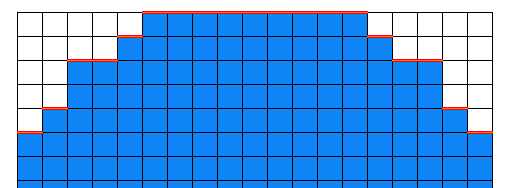π -xelated
Carrie wants to display a disk of maximal radius on a n × n pixel screen.
She runs a program that applies for each pixel of coordinates ( x , y ) the following function :
c o l o r ( x , y ) = { blue if ( x − ⌊ 2 n + 1 ⌋ ) 2 + ( y − ⌊ 2 n + 1 ⌋ ) 2 < ⌊ 2 n ⌋ 2 white if ( x − ⌊ 2 n + 1 ⌋ ) 2 + ( y − ⌊ 2 n + 1 ⌋ ) 2 ≥ ⌊ 2 n ⌋ 2 )
![]()
To make sure she actually approches a disk as n is getting bigger, she defines the sequence π n = 4 A n P n 2 where P n is the perimeter of the colored figure on screen and A n its area.
What is n → ∞ lim π π n
Bonus : What can you conclude from this result ?
This section requires Javascript.
You are seeing this because something didn't load right. We suggest you, (a) try
refreshing the page, (b) enabling javascript if it is disabled on your browser and,
finally, (c)
loading the
non-javascript version of this page
. We're sorry about the hassle.
The disk has area A n and the screen has area n 2 . This means the percentage of the screen covered by the disk is n 2 A n . Now, n → ∞ lim n 2 A n = π ( 2 1 ) 2 = 4 π This is because we are essentially doing an integral: as n increases, the size of each pixel becomes insignificant compared to the size of the screen, and the so the area approaches the area of a circle with a radius of a half.
Now let us look at the perimeter. Consider all the top edges of pixels that make up part of the perimeter, highlighted in red here: Since there is one line segment for every column of pixels, all the top edges total to exactly
n
. Repeating this for the 3 other sides, we find that the perimeter is always
4
n
, so
P
n
=
4
n
.
Since there is one line segment for every column of pixels, all the top edges total to exactly
n
. Repeating this for the 3 other sides, we find that the perimeter is always
4
n
, so
P
n
=
4
n
.
This is a well known trick for falsely proving that π equals 4. Starting with a square, we can indent the corners in such a way that the area approaches the area of a circle, but the perimeter stays the same.
Now we can find the solution to the limit in the question: n → ∞ lim π π n = n → ∞ lim 4 π A n P n 2 = n → ∞ lim 4 π A n 1 6 n 2 = π 4 n → ∞ lim ( n 2 A n ) − 1 = π 4 ( 4 π ) − 1 = π 2 1 6